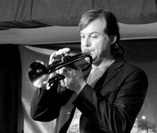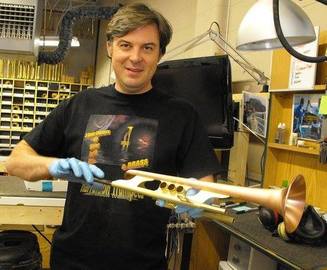 Building a trumpet (2012) Building a trumpet (2012) Have you ever had an experience where you feel like you should know something, but no matter how hard you try you just cannot remember? This happened to me last night as Jolene and I went to see the new Spider-man 2 movie. I asked her a bit about the plot of Spider-man as I could not remember the story. The more she told me about the previous movie, the less I felt connected to any memory of knowing Spider-man. The really strange thing is that according to my Mom, he was my favorite super hero. She even made me a handmade Spider-man costume when I was five years old! In reality, I have this experience many times every single day. Sometimes I catch myself wondering about fourth grade... Where did I live? Who were my friends? What did I like back then? And other times I cannot remember how to spell words or even read them. The most frustrating experiences involve forgetting details about close friends, relatives and major experiences in my life. Sometimes I feel l have forgotten everything and other times I am reassured that it will all come back to me. Exactly two years ago, on May 11th 2012 I survived a very serious stroke. And two days before my stroke, I survived a heart attack. Considering that having a stroke is the leading cause of disability, I am very fortunate to now be healthy. In fact, I was quite healthy before these events, but unknown birth defects in my heart and brain threatened my life. Medical tests finally confirmed that the hole in my heart and missing carotid artery were the source of my headaches, paralysis, dizziness, memory and vision problems I had been experiencing regularly since childhood. Despite visiting doctors and emergency rooms over the course of the previous 25 years, my concerns that I had experienced strokes and heart attacks were always dismissed as paranoia. The scenario played out almost exactly the same every time. I would offer my symptoms and the doctor would then take my blood pressure, listen to my heart beat and then tell me I was perfectly fine. I would ask for an explanation for my weakness, dizziness, poor vision, blackouts, arm or leg pains, sometimes even a visible limp, blinding headaches, shortness of breath, etc. And the response was always the same, "You are clearly very healthy, fit and read too much about health problems...you're far too young to experience a stroke or heart attack". In reality, I have been recovering from these events since at least 5th or 6th grade, which is the first time I can account for the symptoms. We lived on the outskirts of town and I liked going fishing with my friend Rick at the nearby ponds. I apparently went fishing alone this time because my memory begins late at night. I was lying on the ground next to my fishing pole and had no idea where or why I was there. I walked home by moonlight and was punished the next day for coming home so late. My parents didn't buy my story that I just woke up on the ground with no memory of the previous events. As I entered high school, I joined track and ran the one and two-mile events. Within the first few days, I had a strange event after track practice. I found myself lying on the floor of the school hallway hours after school had ended. I was completely confused. Eventually the blackouts became more common, always followed by memory loss and disorientation. My Mom took me to the hospital and the doctors performed numerous medical tests, but found nothing. Then I had a CAT Scan and a few days later I met with a specialist. He told me that I most likely had a tumor in my brain and that there was nothing they could do for me. I didn't completely understand the specifics, but his words were clear, I would not live very long. At first, I felt relieved to know there was something wrong with me. I had been dealing with the prospect that my parents and friends didn't believe my symptoms were real. I remember crying for hours the very first night wishing that I wouldn't hurt my Mom, Dad and sister by dying. We had lost my Mom's brother very suddenly the year before and I could only think about the pain this would cause everyone. When I woke up the next morning, I clearly remember thinking that being alive is my goal. I will do anything to stay alive and healthy. I vowed to make the most of every single moment and love every experience. I was fourteen years old. Over the years, my symptoms became more serious, often in the spring time, but I didn't mind because I was alive. It didn't occur to me that the diagnosis of a tumor was probably wrong until I was certain I had experienced a full stroke. I lost all feeling and control of my body on my left side while driving. After sleeping for several days, the memory of the event faded and was replaced with the struggle to understand what I was doing with my life the previous weeks and months. The cycle of memory loss immediately after serious headaches, paralysis, etc. repeated until May 11th, 2012. At last, medical professionals had found my birth defects and there was a treatment available! Why am I sharing my medical history with the world in my public blog? I have suffered some very extreme circumstances that were seemingly unexplainable for most of my life. And I would have done anything possible to end this cycle of prosperity (when I was feeling well) and misery when I was ill. When you believe you may die many times over again, you learn to appreciate every moment you do feel well. I recall lying down for days at a time dreaming of regaining my vision, literally daydreaming of sunny blue skies and green grass from my childhood in Yucaipa, California. I do not want others to suffer and I cannot be the only person with these problems. In fact, there are millions of people in a similar situation who have not be diagnosed with heart defects. I am not a medical professional, but I can tell you from first-hand experience that it is not normal to have any of the serious symptoms I have mentioned. And sadly, seeing a doctor may not get you anywhere even if you tell him/her that you suspect a serious problem. In my case, doctors did not believe me until the day my stroke was confirmed by an MRI approximately 8 hours after the fact. So what can you do? First, never give up! Second, learn as much as you can about your symptoms and likely causes. I was 100% sure about my heart attacks and strokes even though the medical professionals did not take me seriously. However, I did some very important things all on my own that likely saved my life more than once. I drink a lot of water, which naturally thins your blood. I do not drink alcohol or use tobacco. And I am conscious of everything I eat and drink. I also stay in good shape physically, which was probably the greatest contributor to surviving. Today, I am very healthy and I will likely not experience another major event until I am very old. I struggle with my memory daily as the last stroke was probably the worst and it literally disconnected most of my visual memory and language from my conscious mind. I'm working very hard to re-establish those memories and I bring this up because some of you may be reading this wondering why I haven't called or written. It could be that I have simply forgotten your name or face unintentionally. If this is the case, please take the first step and drop me a line so we can reconnect. A good friend of mine was kind enough to call me (right after my stroke) to say hello and invite me to his home for the weekend. I remembered his name, but I didn't really make the connection for several months. He said something like, "Come visit me in LA and my wife and I will make you a wonderful dinner...you will love it here." A few weeks later, he called again and, amidst my confusion and memory loss, I wondered, "how well do I know this person?" Then one day it clicked and I knew him instantly! The memories were coming back and I was very excited to recall that Arturo Sandoval was in fact my good friend. We had spent time together just the year before playing trumpets in my Minneapolis shop and hanging until all hours of the night after his concerts at the Dakota. I first met Arturo at an ITG conference years before and he came to my table to play my trumpets on every visit. How could I have forgotten Arturo? A major stroke will erase almost every memory for at least the first few month of recovery and possibly forever. I talked to Arturo a few weeks ago as he was very excited to let me in on something truly unbelievable. He had finished mixing the new Spider-man 2 soundtrack with Hans Zimmer and the first two minutes of the opening scene were played on the trumpet I built him. It is fitting that as a five-year-old boy, Spider-man was my hero and now, at thirty-nine-years-old, my hero Arturo Sandoval is playing the trumpet I built on the latest Spider-man movie. Seeing the movie for the first time in the theater just last night and hearing his signature huge, bold and expressive sound as the camera followed Spider-man swinging from skyscraper to skyscraper inspired this entire blog entry.  Jolene and I (2013) Jolene and I (2013) I cannot tell you how great it feels to be alive today and everyday. I am so very grateful for all of my family, friends, clients and those of you I have never met. I'm sure I will meet many of you someday as we eventually cross paths. Jolene deserves special recognition as she has endured many long conversations that led me to re-establishing many more memories and inspiration to recover quickly. I cannot imagine a more beautiful life than waking up every morning healthy and by your side. My Dad has been extremely supportive over the past two years taking a great deal of his time to help move across the country, set up my new shop and test new Mexican restaurants. And Jen was there to help me hold Harrelson Trumpets together when I had no real understanding of my company. She forced me to walk when I literally could only limp, getting me back on my feet in just a few months. Anyone who has received a trumpet, accessories or service from me in the past two years can thank my closest friends and family more than me! I am thankful that Arturo never gave up on me despite my long recovery and memory loss. Few people have shown me such kindness, sincerity and patience. We share a true passion for life, love and freedom and I am forever grateful for your friendship. 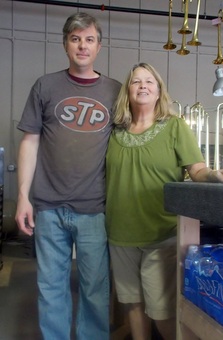 Mom and I in Denver (last week) Mom and I in Denver (last week) And likewise, so many of you have been extremely patient as I re-learn how to do almost everything. I truly appreciate your kindness, patience, support, words of encouragement and friendship. Today is Mother's Day and I obviously would not be here if it weren't for my own Mom, Beth Kocab Harrelson. I know it pains you to read this blog entry, but this has been my reality. And you have been there for me again and again throughout my entire life. I was incredibly lucky to have survived birth (that's another story) and to have you as my greatest role model as a child was an unfair advantage. You helped me plant my first bulb, which blossomed into a beautiful yellow tulip the following spring. You challenged me to ski down the steepest slopes at Bridger Bowl. And you showed me that anything was possible if I only take action. I love you Mom. Please remember to take your daily aspirin and drink a full glass of water before bed and when you wake up in the morning! :) The majority of us will experience a preventable stroke or heart attack. I emphasize PREVENTABLE in hopes that you will take the next few minutes to educate yourself further on the subject. Choosing to act on this advice may someday save your life.  In fact, based on the number of visitors to my blog in the past week, over 7,000 people may read this post within the next seven days. More than one third of you may have some form of cardiovascular disease. That's approximately 700 visitors to my website per day. If this message reaches even a few of you, reminding you to take preventative action, lives can be saved. This chart is available on the American Heart Association website. Please take time to read more at www.heart.org and make the most of every day.
12 Comments
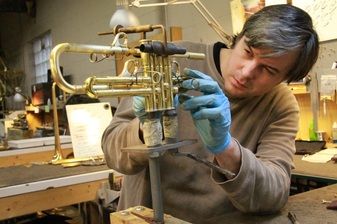 I came in to the shop late today getting in at 6:45 rather than my usual 5:45 as I decided to sleep in one extra hour since I didn't go home last night until almost 8pm. I was greeted this morning by two messages from a prospective buyer on eBay who was venting frustration with my, "unfair" pricing, which further encouraged me to finish this blog draft. If you are not interested in hearing my opinions on high quality precision manufacturing of innovative physics-based trumpets and accessories, now is your chance to click the back button! Having endured criticism for most of my life, I have come to understand that the intent of those offering advice is usually to inform, challenge or even change my behavior. I get it. You have a different perspective and you feel compelled or even obligated to let me know that I'm not on track with your personal expectations. Perhaps you see others in my role saying and doing things differently so you expect the same of me. Criticism can definitely be constructive, positive and very helpful so I welcome your thoughts. But take into consideration that I have my own perspective based on personal experiences, thoughts and intentions. I may not make choices based on a lack of knowledge or information as often as you may think. This reminds me of an interaction I had with a young person through the comment option on one of my YouTube videos where I play tested and criticized a Monette trumpet. I was selling a Monette trumpet that was traded towards a new custom Summit and reviewed the horn on YouTube. The title of this video states, "Of all the high end trumpets Jason has play tested this year, this Monette was the most difficult to play a three octave C scale." And within the video I mentioned that the notes in the upper register did not lock in tight, meaning I had a difficult time landing on the intended pitch. Here's a link to the video or you can watch it below. The viewer's comment read, "What I would like to see is a fair test. A new 30th anniversary raja monette with integral mouthpiece and new summit horn. None of this picking up an out of date monette horn and using to represent the quality of all monette trumpets. Not fair or mature." And my response, "I welcome your challenge! Bring in your 30th Anniversary Raja and let's play some duets switching horns. Great horns are timeless my friend." My suggestion was a real-world test where we played a new Summit and a new Raja to truly experience the differences and have a conversation. This person was criticizing my own criticism of this trumpet implying I had no real experience with newer models. In reality, I have owned eight Monette trumpets made between 1994 and 2012. These have included the STC, 900 and Ajna II series with one being a Raja variation. My experience with Monette instruments is substantial as I have repaired and modified numerous examples that came in for repair or upgrades. In my opinion, Monette instruments are very high quality and are definitely easier to play than most factory built trumpets. I truly appreciate the innovative side of this company. However, Monette is faced with the same challenges as all other manufacturers concerning subjective adaptation, efficiency, impedance, resonance and the laws of physics. And until they address their weaknesses in design and construction, the same problems will exist within this brand of instruments. I am stating this from first-hand experience playing dozens of examples with the perspective of a solid understanding of physics and trumpet performance. They do great work, but like myself and all others, they could do it better. I am a very open-minded person with a critical mind. I appreciate those who pursue their own vision giving their ideas shape and structure until they are thrust into physical reality. I appreciate those people so much that I mentally consider what they could have done better. This is my internal criticism at work and I apply this to my own vision more than all others. I am literally the most critical advocate and initiator of change within my reality. Essentially, this means I spend a lot of time thinking about what I could have done better and then I go do it better! 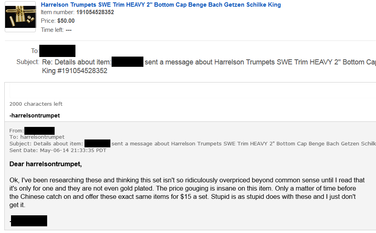 Getting back to the subject of criticism, the prospective eBay customer I mentioned earlier was upset by my pricing of SWE Bottom Caps and full trim kits. I am guessing the person is equally as concerned with the pricing of my instruments as is apparent upon reading the message in the photo to the right. He states, "Ok, I've been researching these and thinking this set isn't so ridiculously overpriced beyond common sense until I read that it's only for one and they are not even gold plated. The price gouging is insane on this item. Only a matter of time before the Chinese catch on and offer these exact same items for $15 a set. Stupid is as stupid does with these and I just don't get it." Clearly this person is under the impression that my company is charging too much for bottom caps! He also seems to think that Chinese manufacturing is the solution to his "pricing" problem and it is only a matter of time before they will start offering this product for $15 a set. As you can imagine, I have a lot to say about this message. But first let me thank eBay member "dxxxxx7" for the constructive criticism. You have encouraged me to give perhaps the longest explanation in history on pricing an eBay item. As a side note, did you notice priority shipping is only $5? The first question that comes to mind, "Why do you need these bottom caps in the first place?" This is an important question as it may reveal why this person believes the pricing is a problem. Assuming this person is male, he states that he has been researching "these". Considering my company is the only company offering SWE products, I would assume his research would only lead back to my website. SWE is short for Standing Wave Efficiency and despite years of layman criticism, it is true physics applied to brass playing. SWE products do in fact increase efficiency in all brass instruments improving stability, slotting and flexibility. I'm guessing that he did not research SWE, but rather looked up "heavy bottom caps" as he does not realize SWE is what he is really purchasing here. This brings up an interesting piece of psychology and having been a student of the mind for most of my life, I enjoy breaking down the decision making process within individuals. This person is most likely interested in my SWE Bottom Caps solely based on the visual information depicted within the photos. Why? Because most of us trust and act upon visual cues more often than real information. You don't believe me? Consider the scenario where you are driving to work in a hurry because you left home a few minutes late. You see flashing red and blue lights in your rear view mirror and pull over to the side of the highway. Your first thought quickly turns into many frantic thoughts, "oh no, I was speeding but how fast was I really going? ...did I stop at that last stop sign? ...where's my insurance card? ...registration? ...I'm going to be late!" The police officer sits in his car for what seems like an eternity before walking up to your passenger side window... But how do you know this is a police officer? Were you really speeding? Based on the visual of the red and blue lights behind you, it is possible that you fabricated all of those frantic questions as a form of explaining the situation. Did you even check to see if the car behind you is in fact a patrol car? Why not? Almost all of us will pull over and assume we are dealing with a police officer based on the red and blue lights. I know this from first-hand experience since I am a former Las Vegas police officer. Your brain will trust visual cues blocking out almost everything else during critical decision making moments. The evidence is overwhelming and the mountain of published studies would take a lifetime to review. Almost all of us pull the trigger on a purchase or action based on the neurons firing in our brains after our visual cortex is fed images that we deem satisfactory. 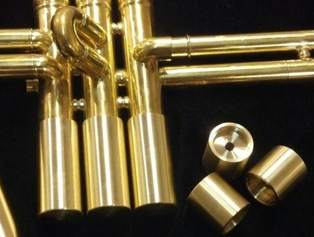 The "visual" thought process goes something like this; I see cool bottom caps... must have cool bottom caps... oh my, how can bottom caps be so expensive? I would step back for a minute and let go of the visual information. I personally do not want you to buy my products based on how cool they look. I do take in pride in making things look appealing, but my vision involves much more. I want your brass playing to improve. I want to help you succeed. This is one of many reasons I love my company, my products and working with musicians from every walk of life from every corner of the globe. I encourage you to take the time to know what you are purchasing and why. Making decisions based on the visual is similar to not thinking at all. Would you give your son or daughter $300 or even $3000 to buy something special only to learn they bought something based on how cool it looked? Likewise, reconsider products that are heavily endorsed by famous artists or celebrities. Are you purchasing an endorsed product for the value it brings to your experience or did you simply recognize a name and face? Dig deep and learn as much as you can about what you purchase as being an informed consumer will often bring greater rewards. To be clear, the SWE Solutions that I offer are valuable to brass players due to increased Standing Wave Efficiency. They are much more than big chunks of brass. And in reality, I personally do not recommend sizes larger than 3/4" as the law of diminishing returns applies. Unless you really like the look of 2 or 3-inch bottom caps or you have more money than you know how to spend, I would choose something smaller. But what about price? Each 2-inch SWE bottom cap costs $50. That is the individual price so a set of three costs $150! I agree, that is a lot of money for one set of bottom caps so let's break down the cost to better understand my pricing.  First, let's consider the price of solid Brass (alloy 360) rod which I purchase in 1-inch diameter bars in 6-foot lengths. Today's cost of one bar is $131.52 according to my supplier, but the price fluctuates daily. By dividing $131 by 72 inches (6 feet), the cost per linear inch is $1.82. Now let's consider how many 2-inch bottom caps I can make from one 6-foot bar of brass stock. My CNC Lathe can only feed bars 32 inches in length so I must cut the bar into three pieces, two measuring 32" and one remnant 7-3/4". The missing 1/4" became chips the width of the saw blade I used to cut it. Starting with one 32" length, I can safely produce fourteen 2" bottom caps. Here's the math... 2.0" + .125" (cut-off tool width) + .005 (facing) = 2.13" per bottom cap. Dividing 32 by 2.13 equals 15.02. This means I can safely cut 14 bottom caps and have around 2.18" left. Why can't I use the last 2.18" to make a 2.13" bottom cap? There is not enough material left to safely hold the stock while it is being machined. To save you the trouble of reading more long-hand math, I will give you the results. I can cut 31 of these bottom caps from one 72" bar of brass. The cost of material is $4.24 each, which is relatively expensive when compared to cheaper materials used in mass manufacturing processes. Now let's consider the machine used to precision machine all round SWE accessories. My CNC Lathe is actually what is known as a Mill/Turn Center. This means that it was designed to turn the stock and remove material with cutters moving in the X and Z axes. And it also turns special live milling tools like a milling machine in the X, Y, Z and C axes to remove material. In addition, this machine incorporates a sub-spindle so that the part may be transferred from the first cutting operation to the second where the part is finished with turning and milling in one complete setup. The entry level price for a machine with 26 tools, live machining and a sub-spindle is well over $200,000 and most of them run $300k+. Now let's consider the cost of tooling, machining time, maintenance, my time, the time of my employees and the cost of keeping the lights on. The largest expense in our company is also our greatest asset...our team! I usually refer to Harrelson Trumpets as "Our Company" since there are five individuals that work tirelessly to bring you innovative cutting edge solutions. I machine everything personally including all hand work required to shape, fabricate and cut materials within the vast majority of components in our trumpets and all accessories. I do all of this myself for many reasons, but mostly because I love the challenge of doing things right. Precision machining is almost a way of life. Sure, I'm messy when I play a solo chorus in a Jazz combo, but when it comes to building trumpets (or anything) I'm all about precision, intention and quality. I put 100% of my focus and energy into creating products with my name on them so I really do care about every single little piece of the process. I earned around $30,000 last year working over 4200 hours so I may be one of the lowest paid precision manufacturers in the country. But at the end of the day, I am doing what I love and I believe reinvesting in our company is more important than having more money. The rest of the Harrelson Team is extremely busy as well. James regularly logs 45-50 hours a week performing final solder removal, clean-up, brushing and plating/lacquer preparation of trumpets and accessories. He also cuts, polishes and sets solid stone and other material inlays into finger buttons and bottom caps. Christine works on inlays as well while heading up our customer service role. She answers the phones, most email messages, handles billing, shipping and logistics and she operates the CMM (coordinate measuring machine) to measure customer mouthpieces for reproduction within the 5MM system. Jen handles most of our Public Relations including social, web and print media while working directly with clients on interviews, photography and the visual side of our company and products. And James Knabe has dedicated himself to traveling the country offering masterclasses and clinics on trumpet performance and Harrelson trumpets and accessories. He is your opportunity to try our horns in person no matter where you live across the USA. The greatest cost in producing SWE Bottom Caps is handling each item so many times. Unlike Chinese factories where the focus is on producing a large number of items resembling the original, we make sure every item that goes out the door is made to our high standards in design, function and finish. How much time is involved in delivering a 2" bottom cap?
 The complaints by eBay member dxxxxx7 helped reaffirm something that has bothered me for many years. We live in a world of low standards where the monetary price is most often considered the best choice. This cheap mentality has been propagated by chains like WalMart, eBay, Taco Bell and has spread to almost all product lines including computers, automobiles, groceries, homes and now brass instruments. Of course cheap trumpets have always been available, but the general attitude that all things should cost very little money is relatively new. The major difference between Harrelson Trumpets (custom precision machining with real intent to make an innovative product) and cheap mass produced Chinese parts comes down to a few basic elements;
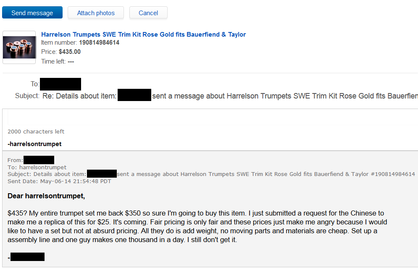 I received two complaints from this eBay member, the second is shown in this photo. He exclaims that, "Fair pricing is only fair and these prices just make me angry because I would like to have a set but not at absurd pricing." When did society shift towards the attitude that "Fair" is reflected in a low price for the consumer? Who created the business and all the processes involved in bringing these products into existence? And should that person (me) not be paid a "fair" wage? A cheap product was once considered the least attractive option. The cheap option was reserved for those rare times when the product would only be used once or twice or possibly consumed/destroyed within the process of use. An example would be purchasing cheap batteries for a flash light that you knew would only be used once or twice within the next few weeks. It would be counter-intuitive to purchase cheap batteries for a flash light you may need in an emergency three years from now for obvious reasons. The same is true of a shovel. It may sound like common sense, but you wouldn't buy a cheap shovel that is likely to break due to poor quality, workmanship and design if you were going to dig all day. Sadly, much of our society has caught the "Cheap" bug and the infliction is apparently leading to full fledged entitlement issues. Claiming that a price is unfair is ridiculous and I don't care which product you are referring to including the cost of gasoline, a steak dinner or a nice hotel room. The price of a product is an agreement between a buyer and a seller to exchange money for goods or services. If you don't like the price, don't buy the product. And if you believe the price to be unfair, take a minute to consider what is involved in producing that particular product. I know thousands of people who believe gasoline is unfairly over-priced yet they have failed to show me an alternative product or process that will fuel a 4000 pound vehicle to travel 22 miles per gallon for $3.50. How much would you charge to personally move 4000 pounds a distance of 22 miles? When you think about the value of gasoline, it should probably cost around $30 or even $50 a gallon, but thanks to an entitled cultural attitude we lazily complain. How much does an oil drilling operation cost? How about an oil refinery? What about distribution and safety? Gasoline is one of the least expensive valuable commodities you will ever purchase! The only time the price of a product could be deemed unfair is in the case of hidden fees, taxes or other costs that are not directly reflected within the intrinsic value received, but that's another story. So dxxxxx7 wants a cheap trim kit costing $25 for his cheap Chinese trumpet that cost him $350. That's fine by me, but why stop there? Why not add a cheap car and gasoline so he can drive to his cheap paying job where he serves cheap burgers to other cheap people so he can pay cheap rent? At the end of the day, a cheap paradigm will buy you nothing but a cheap world. Where will you find innovators, dreamers and artists in a world of cheap mass production? Most likely sketching ideas on napkins. Then turning those first few ideas into something that resembles their initial vision until someday, many dedicated years later, it blossoms into a world of previously unimagined beauty inviting all those with imagination to explore, grow and understand on a new level. And what is the cost of this new world of possibilities? Anything but cheap because those who raise the bar to a new level have spent all of their time, energy and money creating this new reality. It is there for you to enjoy if you're not too cheap to jump in and try it for yourself. I started this company with nothing but ideas. I had absolutely no money, no experience, no skill, no mentors, no education and no allies. I created value where there was none by devoting my entire mind, body and soul to advancing brass instruments. My products are extremely valuable, rare and worth every penny. I know this to be true since I designed, built and tested every one of them. |
Jason Harrelson
Inventor, Musician, Educator and Founder of Harrelson Trumpets, Trumpet Momentum and Harrelson Momentum. Archives
July 2024
|

 RSS Feed
RSS Feed
